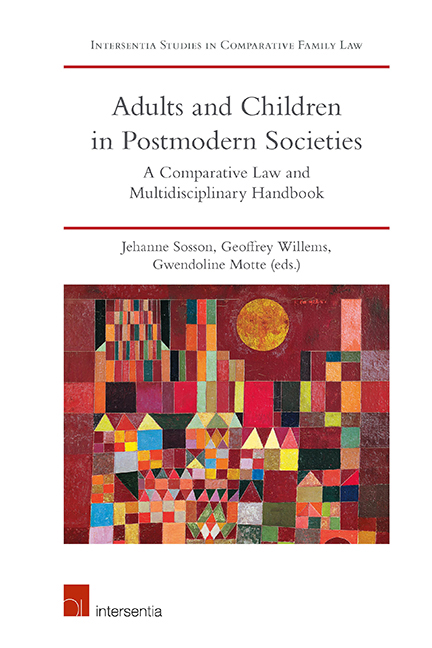Book contents
- Frontmatter
- Contents
- List of Cases
- List of Contributors
- Introduction
- PART I NATIONAL REPORTS ON LEGAL REGULATIONS OF RELATIONSHIPS BETWEEN ADULTS AND CHILDREN
- Questionnaire
- Models
- Algeria
- Argentina
- Australia
- Belgium
- Canada
- Democratic Republic of the Congo
- England and Wales
- France
- Germany
- Ireland
- Italy
- Japan
- The Netherlands
- Romania
- Spain and Catalonia
- Sweden
- Switzerland
- United States of America
- PART II INTERDISCIPLINARY APPROACH
- PART III INTERNATIONAL LAW INSIGHTS
- PART IV COMPARATIVE APPROACH
- General Conclusion: The Challenge of Transparent and Inclusive Parenthood/Parentality in a Pluralist and Cosmopolitan Context
- About the Editors
The Netherlands
from PART I - NATIONAL REPORTS ON LEGAL REGULATIONS OF RELATIONSHIPS BETWEEN ADULTS AND CHILDREN
Published online by Cambridge University Press: 26 June 2019
- Frontmatter
- Contents
- List of Cases
- List of Contributors
- Introduction
- PART I NATIONAL REPORTS ON LEGAL REGULATIONS OF RELATIONSHIPS BETWEEN ADULTS AND CHILDREN
- Questionnaire
- Models
- Algeria
- Argentina
- Australia
- Belgium
- Canada
- Democratic Republic of the Congo
- England and Wales
- France
- Germany
- Ireland
- Italy
- Japan
- The Netherlands
- Romania
- Spain and Catalonia
- Sweden
- Switzerland
- United States of America
- PART II INTERDISCIPLINARY APPROACH
- PART III INTERNATIONAL LAW INSIGHTS
- PART IV COMPARATIVE APPROACH
- General Conclusion: The Challenge of Transparent and Inclusive Parenthood/Parentality in a Pluralist and Cosmopolitan Context
- About the Editors
Summary
Recently, the relationships between adults and children were at the centre of attention due to an important report of the so-called Government Committee on the Reassessment of Parenthood. The Committee published its report Child and Parents in the 21st century in December 2016. Many adaptions to the current family law have been proposed, among which the introduction of parenthood for more than two persons and regulation of surrogacy. These proposals haven’ t resulted in new legislation yet as the new government requested more research on the consequences for taxes, nationality law, immigration law, succession law, maintenance obligations and the law on surnames.
In 1998, registered partnership was introduced in the Netherlands, allowing same-sex couples a way to formalise their relationship. This partnership has always also been open to heterosexual couples. The registered partnership was followed by the introduction of same-sex marriage in 2001. Nowadays, the legal differences between a registered partnership and marriage are negligible. For reasons of simplicity, use of the word marriage will therefore hereafter also cover registered partnership unless otherwise indicated in the text.
CHANGES IN THE TRADITIONAL FAMILY
A. MOTHERS
1. Is maternity automatically established by the birth certificate?
Declaration of a birth takes place by informing a civil registrar of the birth within three days following this event. The birth mother is authorised to declare the birth herself, but is not obliged to do so. By contrast, the spouse of the birth mother is obliged to declare the birth. If no spouse exists or if the spouse is unable to fulfil this duty, the obligation is transferred to the people that were present at the time of birth or, if this is also impossible, to people living in the house or in charge of the institution where the birth took place (art. 1:19e Civil Code (Burgerlijk Wetboek), henceforth referred to as BW).
Although registration of a birth is compulsory, it isn’ t the way in which maternity is established. In Dutch law the principle mater semper certa est applies; the birth mother of a child is always its legal mother, art. 1:198 BW. Maternity is therefore already established by birth, not by a certificate.
- Type
- Chapter
- Information
- Adults and Children in Postmodern SocietiesA Comparative Law and Multidisciplinary Handbook, pp. 417 - 450Publisher: IntersentiaPrint publication year: 2019



